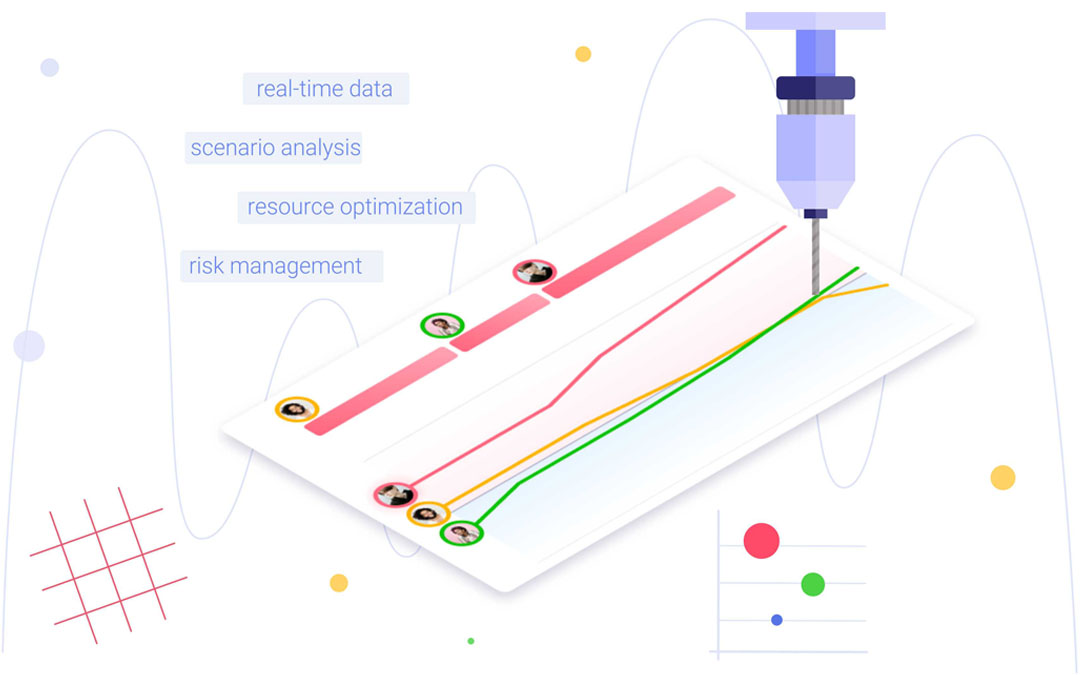Have you ever faced unexpected setbacks in a manufacturing project that affected its timeline and budget? If so, it’s hardly surprising—a great number of projects are exposed to industry challenges or unfavorable external events. Neglecting these risks can lead to project delays, budget overruns, and even project failure, which will negatively impact a manufacturer’s reputation. Therefore, a proactive approach to effective risk management is critical.
Read the article to explore typical difficulties impacting manufacturing projects and learn the strategies to manage risks in manufacturing projects most effectively.
Typical Risks in Manufacturing Projects
Manufacturing projects can be significantly affected by risks faced by the industry in general. Let’s take a look at the most essential ones.
Supply chain disruptions
This challenge is typical for a great number of industries, and despite considerable efforts still exists in today’s post-pandemic world. In addition, geopolitical tensions and military conflicts don’t add to supply chain stability. Supply chain disruption involves raw material shortages, delays in transportation, trade restrictions, and more. Obviously, these problems result in delays in manufacturing projects and cost overruns.
Equipment failure
The manufacturing process is impossible without machinery, technology, and tools. In turn, they aren’t immune to breakdowns, especially when it comes to outdated or poorly maintained equipment. Similar to supply chain disruptions, equipment failure increases projects’ lead times and causes budget overruns. In addition, problems with equipment may cause additional risks related to workers’ safety and product quality.
Risks related to advanced technology use
Even though manufacturers implement the latest technologies to increase operational efficiency, these technologies may pose additional risks. For example, the employees may take more time to get a handle on new equipment or digital tools. Second, innovative technology may not bring the expected results at once. Finally, the increased use of digital technologies makes manufacturers vulnerable to cyber attacks that can disrupt the whole production process. All these factors may lead to manufacturing project delays or compromise on the quality of the manufactured product.
Workforce shortage
Manufacturing companies have been struggling with several ongoing workforce challenges:
- an aging workforce,
- a shortage of skilled professionals,
- competition for digital talent from other industries,
- persistent difficulties in retaining employees.
For example, the manufacturing industry in the U.S. is the most impacted by talent shortages [1]. These problems cannot be addressed quickly enough, which creates an additional challenge—the need to deliver more products with limited resources. So, manufacturing project managers should keep these resource-related risks in mind when planning and managing their projects.
Project management risks
Like projects in other industries, manufacturing projects are exposed to various project management risks, e.g., scope creep which is a result of making uncontrolled changes to the project scope, improper planning, and other risks affecting all aspects of the project: budget, resources, schedule, quality, etc.
Risks related to regulatory compliance
Compliance with industry standards and regulations is a must for manufacturing projects; they regulate safety issues, facilitate sustainability and strict quality control, etc. The inability to meet these regulations results in fines and penalties and can damage a company’s reputation. Also, these factors can cause significant project delays and even stop the whole project.
Safety risks
The manufacturing process involves working with machinery and raw materials in a highly risky environment, which cannot but affect manufacturing project management. For example, heavy equipment or moving parts may cause injuries, especially under conditions of improper maintenance and inappropriate safety training. Accidents in the manufacturing environment lead to project delays and additional expenses, which inevitably affect project success.
Market risks
This group of risks involves market fluctuations, changes in customers’ demand, changing prices for materials, or economic conditions in general, which adds uncertainty to manufacturing projects and can negatively affect project planning and workflow. For example, if a project outcome fails to meet the changed customer demand, it will result in financial losses and a damaged reputation of a company.
As we see, manufacturing risks are diverse, and the importance of proper risk management cannot be overestimated. So, let’s now review the significance of proper risk management in more detail.
Importance of Risk Management in Manufacturing

In a nutshell, effective risk management won’t let risk-bearing events derail their projects causing delays, budget overruns, poor quality, or other problems. Here are the other benefits of risk management for manufacturing projects.
Timely problem identification
Risk management involves assigning team members to monitoring and managing risks. This helps early detect any risk-bearing events that could disrupt the workflow (supply chain delays, equipment failures, etc.). As a result, manufacturing project teams can take timely corrective action and reduce the potential negative impact on the project flow. In the dynamic manufacturing environment, timely problem detection and prevention is critically important, as it helps avoid costly delays in the production and project flow.
Preparing proper responses to risk-bearing events
A proactive approach to risk management allows manufacturing project teams to develop effective response plans; they will be able to mitigate the impact of risks before they can derail the project. In addition, risk management enables manufacturers to take advantage of opportunities provided by the so-called positive risks and improve project outcomes.
Minimizing financial losses
This is one of the most significant benefits of risk management in manufacturing projects. Whether it’s preventing unfavorable events or addressing risks to avert their negative consequences, properly developed risk management strategies will minimize the likelihood of unplanned expenditures and protect the project’s profitability.
Improving project performance
Thanks to effective risk management, the project team can anticipate potential roadblocks, tackle them before they escalate, and avoid significant disruptions. When you quickly address risk-bearing situations, projects stay on track, which improves their overall performance. This is particularly important for manufacturing projects with strict schedules and stringent demand for quality.
Key Steps in Manufacturing Project Risk Management
Risk management can be divided into several stages, each of which is essential for the success of the whole process.
- Identifying risks.
This involves a close look at every aspect of a manufacturing project. The most common risk identification methods include brainstorming, the analysis of historical data from previous projects, and interviews with critical employees.
- Risk assessment and prioritization.
Having identified all potential risks, you should assess them in terms of their likelihood and impact on the production process. After that, you need to prioritize them depending on the above-mentioned criteria so that the team won’t lose focus of the most serious and probable risks.
Read more: Creating a Risk Register: All You Need to Know
- Risk mitigation planning.
You need to plan a response to each identified risk, which will outline the necessary actions (avoid a risk, escalate, mitigate, transfer). This may require assigning additional resources, adding time and capacity buffers, changing timelines, etc. Preparing risk responses will prevent a project from derailing and increase the predictability of the workflow.
- Monitoring and controlling.
Risk management is a continuous process, which means that risks should be regularly monitored throughout the project lifecycle, and the risk mitigation plan should be updated if necessary. This approach will protect projects’ flow from disrupting events and facilitate seamless project execution.
Let’s now explore recommendations that will help you make the risk management process in your organization as effective as possible.
Best Practices for Effective Risk Management In Manufacturing Projects

Prioritize risks
Effective risk management is impossible without risk prioritization, as not all risks will have the same impact on a project. You can use various techniques (e.g., risk matrices) to assess the likelihood and potential impact of each potential risk-bearing situation. This will help you focus your efforts on the most serious risks and mitigate their disruptive impact as well as timely allocate required resources to respond to these events.
Leverage scenario planning
Scenario planning will help you simulate various disruptions (e.g., material shortages, machinery breakdowns, etc.) and their probable impact on the production process, and prepare effective contingency plans. You can also simulate changes and risks in the project flow. Leveraging advanced project management software will allow you to run simulations to spot potential risks (e.g., resource overload or production delays) and try out responses to them.
Therefore, scenario planning reduces uncertainty and facilitates informed decision-making when risk-bearing situations occur—you can act faster and effectively prevent issues in the production and project flow.
Utilize predictive maintenance
As manufacturing projects involve work with equipment and machinery, it’s critically important to make sure that they are well-maintained and properly functioning—this will significantly reduce risks related to equipment failure. IoT and AI-powered systems will help you monitor equipment state and forecast when maintenance will be needed. This will prevent unexpected breakdowns and minimize the probability of production and project delays.
Facilitate stakeholders’ involvement
Risk management isn’t the responsibility of a single person, so it’s a good idea to engage various stakeholders (senior management, team members, customers, suppliers, etc.) in the risk management process. This will help you identify risks from different perspectives and get a full picture of possible threats and opportunities in a project. In addition, this will share responsibility for managing risks between different departments, which will also increase the effectiveness of the risk management process.
Work on supply chain resilience
Supply chain disruptions are one of the biggest sources of negative risks in the manufacturing industry. At the same time, supply chains haven’t returned to their pre-pandemic resilience, which emphasizes the need to take action to minimize disruptions. Manufacturers should evaluate and diversify their supply chains to reduce dependencies on single sources or suppliers. It’s better to consider alternative suppliers and utilize supply chain management software to track orders. Achieving supply chain resilience will reduce disruptions and minimize related risks for the production process and manufacturing projects.
Provide training for employees
To increase the effectiveness of the risk management process, you should provide the team members with regular training on detecting and managing risks. This will equip them with tools and knowledge to monitor risks and respond to them effectively. Team members are first to take actions against potential risks, so they should be well-trained to be able to spot issues early on and mitigate their impact on project success.
There’s one more important ingredient for effective risk management in manufacturing projects—leveraging the right project management software. Read the next section to learn more about their capabilities and role in effective risk management.
The Role of Project Management Software: Epicflow Example

Manufacturing project management solutions are crucial role for successful risk management. Their capabilities make it possible to analyze large amount of real-time and historical data, provide actionable insights based on data analytics, allocate and manage resources more effectively, improve collaboration, etc. Let’s review how PM solutions contribute to effective risk management through the example of Epicflow, a multi-project resource management tool.
Epicflow helps manage risks in manufacturing projects by providing advanced resource and project management insights that improve planning, monitoring, and decision-making processes. Here’s how Epicflow addresses risk management.
- Providing real-time data and insights.
Epicflow provides real-time visibility into the state of the multi-project environment, projects’ progress and resource perfromance as well as visualizes potential bottlenecks. This allows project managers to spot issues early and take timely corrective actions to mitigate risks (a lack of resources, delays, bottlenecks, etc.).
- Scenario analysis.
Epicflow allows users to create multiple project scenarios and test different outcomes, taking risk factors into account. You can run simulations and find an optimum way to respond to a risk-bearing situation, which improves decision-making, makes you prepared for potential disruptions, and helps create effective contingency plans.
- Resource optimization.
One of Epicflow’s strengths is its ability to optimize resources across multiple projects. By ensuring that human and material resources are allocated efficiently, Epicflow reduces the risk of overloading workers or under-utilizing resources, which could lead to delays, inefficiencies, or budget overruns.
- Risk management.
Epicflow helps identify risks related to project timelines, workloads, and resource capacity. This allows project managers to avoid these risks and minimize the chances of project delays or cost increases. Also, like we mentioned earlier, you can test scenarios to find the best possible way to mitigate risks. Finally, Epicflow’s AI assistant Epica gives early warnings upon detecting threats in the project flow and suggests ways to handle them.
Therefore, Epicflow supports manufacturing companies in minimizing risks, optimizing resource utilization, improving project performance, and maintaining production efficiency.
Want to learn more about its risk management capabilities for manufacturing projects? Don’t hesitate to contact our specialists.
Conclusion
Proper risk management is crucial for the success of manufacturing projects that are accompanied by various uncertainties and disruptions. Early identification, analysis, and mitigation of risks will allow manufacturers to avoid significant setbacks in the production process, optimize costs, and ensure the timely delivery of high-quality products.
Utilizing advanced project management software can significantly optimize the risk management process in manufacturing projects, facilitates achieving desired project outcomes as well as improves a manufacturing organization’s production performance.
References
Stevick, K. (2023). Worker Shortage: Overcoming Workforce Challenges in Manufacturing. Retrieved from: https://www.forbes.com/councils/forbesbusinesscouncil/2023/08/25/worker-shortage-overcoming-workforce-challenges-in-manufacturing/

